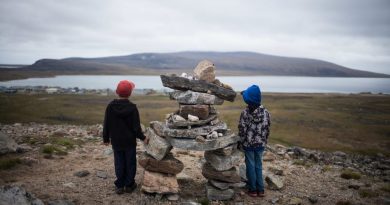Test targets colorectal cancer in Alaska Natives

For Alaska’s indigenous people, colorectal cancer presents a double challenge. Alaska Natives have high rates of the disease, while those living in rural villages have low access to the standard method of screening: the time-consuming, expensive and often uncomfortable colonoscopy.
But now, advances in screening technology and a years-long campaign to raise awareness are paying off.
A new type of at-home test to screen for colorectal cancer proved highly accurate in a recent two-year study examining patients at the Alaska Native Medical Center. The simple test uses a stool sample to determine whether further treatment is needed.
“Basically, it’s like a poop-in-the-box sort of thing,” said Diana Redwood, head of the Alaska Native Tribal Health Consortium’s Colorectal Cancer Program. The stool, once boxed, is mailed to a laboratory; the quality of the test is unaffected if the sample freezes, “which in our state is a huge thing,” she said.
DNA test
The new test detects the presence of DNA shed by polyps — unusual growths lining colorectal tissue — which is different than the body’s normal DNA. Since some polyps can become cancerous, all are removed when found, making colorectal cancer particularly treatable if early detection methods are used.
The most common method of looking for polyps is a colonoscopy, an examination that uses a flexible scope inserted into the large intestine. But few rural clinics offer that service, so many Alaska Natives must travel to Anchorage or another city to get a colonoscopy, a factor that adds extra costs and poses an additional barrier to screening.
Colorectal cancer is the third most common cancer among men and women in the U.S., but it is particularly prevalent among Alaska Natives.
It is now the most frequently diagnosed type of cancer among Alaska Natives, and rates from 2009 to 2013 were about twice those for white U.S. residents, according to a report by the ANTHC Epidemiology Center. Colorectal cancer was the second leading cause of cancer deaths for Alaska Natives from 2003 to 2009, according to other research.
Raising awareness
ANTHC used a grant from the Centers for Disease Control and Prevention to launch its Colorectal Cancer Control Program. The program’s goal is to increase screening and it uses a variety of methods to raise awareness. Among its tools are two inflatable walk-in models of a colon — one of which is small enough to travel to remote communities — and a “Polyp Man” costume that Redwood has been known to don for public-education events.
That campaign appears to be making progress. In the 1990s, screening rates for Alaska Natives were far lower than for non-Natives in Alaska and the U.S. population as a whole. But the gap has narrowed, and in recent years Alaska Native screening rates have equaled or overtaken those for non-Natives. Screening rates in Alaska and elsewhere are on the rise, though they still fall short of an 80 percent national target.
It is not clear why Alaska Natives have such elevated rates of colorectal cancer, Redwood said. Some have speculated there is a genetic link, but none has been found, she said.
Some factors associated with colorectal cancer in the general population — obesity, physical inactivity, tobacco use and a diet with too few vegetables or too much processed meat — might also apply to Alaska Natives, she said.
Smoking rates
The use of tobacco is particularly striking, Redwood said. Alaska Natives have very high smoking rates, about twice that of non-Natives, according to the state Department of Health and Social Services, so smoking cessation efforts are part of the colorectal cancer awareness campaign, Redwood said.
The new stool test, marketed under the brand name Cologuard and developed by the biomedical company Exact Sciences, represents an advance over an older screening system called the fecal immunochemical test, or FIT. The FIT procedure detects blood in the stool, an imperfect screening technique because polyps create bleeding only some of the time and there are other causes of blood that are unrelated to colon cancer.
The study of the Cologuard test’s efficacy among Alaska Natives was led by Redwood and conducted in cooperation with the Mayo Clinic. That study considered 661 patients who came to the Alaska Native Medical Center for colonoscopies between 2012 and 2014. The patients also got the Cologuard test and the older FIT screening. The Cologuard test results perfectly matched those of the colonoscopies, while the FIT test was only an 80 percent match.
The Cologuard test had already passed a clinical trial based on nearly 10,000 patients. That led to approval in 2014 by the Food and Drug Administration, Redwood said.
The cost of the new test is now covered by Medicaid and Medicare, she said.
Related stories from around the North:
Canada: Telehealth in the Arctic – Unfulfilled potential, Blog by Heather Exner-Pirot
Finland: Study finds lower cancer rates among indigenous Sámi, YLE News
Greenland: Researchers must be honest with Arctic peoples about food contaminants: doctor, Eye on the Arctic
Norway: Nordic diet a heart-smart alternative, Radio Sweden
Sweden: The Sami Health Paradox, Radio Sweden
United States: Researchers identify Inuit gene responsible for sugar intolerance, Alaska Dispatch News



